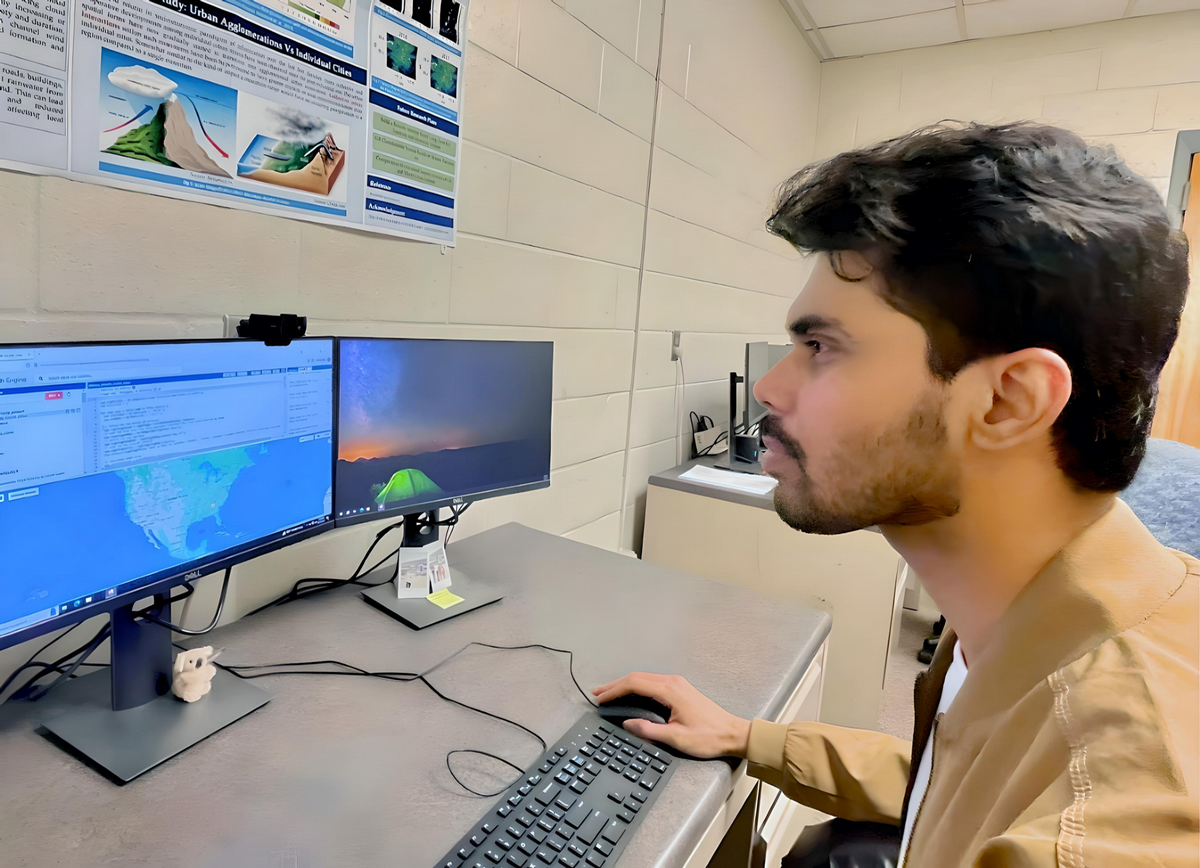COSAM News Articles 2023 October Auburn doctoral student challenges perceptions of COVID-lockdowns' impact on air quality with international team of researchers through NASA project
Auburn doctoral student challenges perceptions of COVID-lockdowns' impact on air quality with international team of researchers through NASA project
Research has indicated that overall air quality had improved during the lockdown from COVID. Most major cities saw improved air quality, making it healthier for residents during COVID. While this was true, a group of researchers from five countries began brainstorming post-COVID phase, whether air quality had similarly improved regionally and/or globally, and whether this claim was biased towards urban centers only. Among these researchers is Subhasis Ghosh, a doctoral student in the Department of Geosciences at Auburn University who played a pivotal role in conducting research using remote-sensing and cloud computing techniques to debunk the published myth that air quality had overall improved during COVID. The team found that there was a huge gap in the way air quality improvement was perceived at different scales, which they published in the Physics and Chemistry of the Earth journal. The article is titled Have COVID lockdowns really improved global air quality? – Hierarchical observations from the perspective of urban agglomerations using atmospheric reanalysis data. The study is part of NASA’s Interdisciplinary Research in Earth Science program led by Dr. Chandana Mitra in the Department of Geosciences, which looks at urban agglomerations and their impact on urban microclimate and urban hydrological processes.
“The study is aimed to answer a pressing question that has captured the attention of the world since the pandemic began: Did the COVID lockdowns genuinely lead to significant improvements in global air quality, or is the reality more complex than we initially thought? Most of the research done at the time focused on air quality within city limits and largely overlooked high-level emitters such as heavy factories, coal mines, and power plants located along the city fringes that were significantly contributing to pollution levels to secure continuous energy supply during the lockdown,” said Subhasis Ghosh, doctoral student in Earth System Science.
According to Ghosh and Mitra, the reduction in pollution is prejudiced by the scale of observation, whether the observations considered were local or regional. “If you are only looking at pollution emissions from cars and planes, you are only seeing one perspective,” explained Ghosh.
The team of researchers completed the first study that includes the missing element by first looking at the bigger picture or global view then narrowing it down to urban agglomerations, and then to just the city level. Urban agglomerations include several large and small urban areas connected to each other economically and physically, spatially spread over large areas, having a collective influence on the region. An example from the US is the urban agglomeration from Boston to Baltimore corridor, all connected and behaving as one unit.
”The research that Subhasis has published is unique as it is not looking at one big city but a group of cities or urban agglomerations,” said Chandana Mitra, graduate advisor to Ghosh. “Millions of people live in the major cities around the globe, which has a direct influence on surrounding ecosystems, but the impact gets amplified when you begin to assess the collective influence of a bunch of cities together on the region,” Mitra added.
The researchers assessed six major pollution indicators including sulfur dioxide (SO2), ozone (O3), nitrogen dioxide (NO2), particulate matter (PM2.5), columnar aerosol optical depth at 500 nm (AOD500), and UV aerosol index (UAI) in the study.
“We found that the impacts were so dynamic that there were spatial variabilities in air quality levels even within a country. If you look at the city level and then move your observation to the agglomeration level and then the regional level, you may have results very different from each other. We found that PM2.5 concentrations significantly increased in Ghana and Russia where most of the other countries showed a decrease by 56% compared to 2019. However, at the same time, Ghana also recorded a decrease in NO2 which was quite interesting to see. Similarly, NO2 concentrations decreased by 3%–31% in most countries but countries like Turkey and Spain exhibited mixed patterns, and countries such as the UK and South Africa showed increases. All the major pollutant parameters also did not seem to have responded in the same way. For example, the Delhi agglomeration in India (Delhi-NCR) showed a prominent decline of PM2.5 whereas in most parts, SO2, AOD500, and UAI presented a mixed pattern fluctuating over the study period. These results clearly indicate that the impact of COVID-lockdown on air quality is completely subjective to the scale of observation and what pollution parameters are being referred to when assessing the air quality standards. It is not a one-size-fits-all scenario,” Ghosh said.
The study therefore challenges the blanket assertion of improved air quality during COVID lockdowns. “Understanding these variations is essential for policymakers and environmentalists seeking to make informed decisions about air quality management. The large urban entities have now gradually started to transform into agglomerated urban ecosystems. Collective interactions within such ecosystems have greater impacts on the local environment than the individual cities. Hence, this factor should also be taken into consideration when performing such investigations," Ghosh added.
The international team of collaborators includes Subhajit Bandopadhyay from the University of Southampton, United Kingdom; Rahul Deb Das from IBM, Germany; Mridul Das from Serampore College, India; Mousumi Chowdhury from Indian Institute of Engineering Science & Technology, India; Alexander Cotrina-Sanchez from Università Degli Studi Della Tuscia, Via San Camillo de Lellis, Italy; and Chandan Kumar from Mississippi State University, United States.
Latest Headlines
-
04/23/2024
-
04/18/2024
-
04/18/2024
-
04/18/2024
-
04/17/2024


